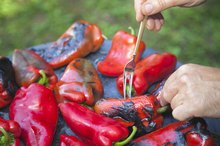Caffeine Content of Dark-Roast Coffee
It wasn't until Starbucks opened its first store in the 1970s that individuals began to use coffee as a dessert or snack and not just a functional method of increasing alertness. It is the caffeine in dark-roast coffee that has central nervous system effects, causing an increase in alertness and productivity 24. Caffeine is naturally found in the beans roasted to produce coffee 24. However, the amount of caffeine in coffee depends on several factors, one of which is the length of time of the roast and the color of the bean 24.
Definition of Caffeine
Caffeine is the ingredient in coffee that may help improve your productivity and mental focus, but also has some significant side effects 24. Consuming high amounts of caffeine every day, such as 600 mg or the equivalent of six cups of coffee, can lead to anxiety, restlessness and sleep disorders 24. Other side effects include irritability, jitteriness and headaches. Caffeine is a central nervous system stimulant that works on the brain by taking the place of adenosine, a neurotransmitter 2.
Roasting Differences
Acids Found in Coffee
Learn More
Coffee beans are harvested and then chemically processed and roasted to produce coffee. The roasting process helps create, balance or alter the flavor, acidity and body of the coffee bean 3. There are several stages in coffee roasting that cause the bean to double in size, change in color and often experience a weight loss 3. As moisture is lost in the bean, it suddenly will pop audibly, sounding a bit like popcorn. In this process, the starches are converted into sugar and the cellular structure of the bean is altered. Heating and roasting the bean releases coffee oil that is volatile and water-soluble 3. Once roasted, the flavor of the coffee bean can be damaged by moisture, light and oxygen. If the beans are roasted too dark, then the oils are burned; if too light, the oils do not precipitate and the coffee has a bitter flavor.
- Coffee beans are harvested and then chemically processed and roasted to produce coffee.
- Once roasted, the flavor of the coffee bean can be damaged by moisture, light and oxygen.
Caffeine in Dark Roast
The amount of caffeine present in coffee depends on several factors 24. Dark-roast coffee has more coffee oil precipitated from the bean, which includes more caffeine 24. The amount of caffeine is also related to the way in which the coffee is brewed and the variety of bean that was chosen for the coffee roast, according to Coffee.org 24. For instance, 4 ounces of Arabica coffee beans produce 100 mg of caffeine when brewed in a drip method, while a 1-ounce espresso shot has 40 mg of caffeine 24. According to Coffee.org, a drip brewing method increases the amount of caffeine that reaches your cup 24.
Benefits of Dark Roast
Is Ethyl Acetate Decaf Coffee Safe During Pregnancy?
Learn More
Dark-roasting a coffee bean does not just impart greater flavor and more caffeine, but it also may create a compound in the coffee that reduces the amount of stomach acid you produce 234. A team of researchers published their work at a meeting of the American Chemical Society in 2010. They compared the chemical profiles of dark-roast coffee and light-roast coffee made with regular roasted and steam-treated beans. The dark-roast coffee had greater than 30 mg per liter of a chemical related to the reduced production of stomach acid, and was linked to less heartburn and fewer stomach problems.
- Dark-roasting a coffee bean does not just impart greater flavor and more caffeine, but it also may create a compound in the coffee that reduces the amount of stomach acid you produce 2.
- The dark-roast coffee had greater than 30 mg per liter of a chemical related to the reduced production of stomach acid, and was linked to less heartburn and fewer stomach problems.
Related Articles
References
- National Coffee Association of the USA: National Coffee Drinking Trends 2008
- Drugs.com: Caffeine
- CoffeeResearch.org: Coffee Roasting
- Coffee.org: Caffeine Levels in Coffee
- Science News: Ingredient of Dark Roasted Coffees May Make Them Easier on the Tummy
- Coffee, brewed, prepared with tap water. FoodData Central. U.S. Department of Agriculture. Published April 1, 2019.
- Caffiene in coffee. FoodData Central. U.S. Department of Agriculture. Published April 1, 2019.
- McCusker RR, Fuehrlein B, Goldberger BA, Gold MS, Cone EJ. Caffeine content of decaffeinated coffee. J Anal Toxicol. 2006;30(8):611-3. doi:10.1093/jat/30.8.611
- Coffee, instant, reconstituted. FoodData Central. U.S. Department of Agriculture. Published April 1, 2019.
- U.S. Department of Agriculture. Coffee, espresso. FoodData Central. Published April 1, 2019.
- Tea, hot, leaf, black. FoodData Central. U.S. Department of Agriculture. Published April 1, 2019.
- Soft drink, cola. FoodData Central. U.S. Department of Agriculture. Published April 1, 2019.
- US Food & Drug Administration. Spilling the beans: How much caffeine is too much?. Updated December 12, 2018.
- Rogers PJ, Heatherley SV, Mullings EL, Smith JE. Faster but not smarter: Effects of caffeine and caffeine withdrawal on alertness and performance. Psychopharmacology (Berl). 2013;226(2):229-40. doi:10.1007/s00213-012-2889-4
- Freedman ND, Park Y, Abnet CC, Hollenbeck AR, Sinha R. Association of coffee drinking with total and cause-specific mortality. N Engl J Med. 2012;366(20):1891-904. doi:10.1056/NEJMoa1112010
- Voskoboinik A, Kalman JM, Kistler PM. Caffeine and arrhythmias: Time to grind the data. JACC Clin Electrophysiol. 2018;4(4):425-432. doi:10.1016/j.jacep.2018.01.012
- Papakonstantinou E, Kechribari I, Sotirakoglou Κ, et al. Acute effects of coffee consumption on self-reported gastrointestinal symptoms, blood pressure and stress indices in healthy individuals. Nutr J. 2016;15:26. doi:10.1186/s12937-016-0146-0
- The American College of Obstetricians and Gynecologists. Moderate Caffeine Consumption During Pregnancy. Committee Opinion: 462. Published August 2010.
- Drake C, Roehrs T, Shambroom J, Roth T. Caffeine effects on sleep taken 0, 3, or 6 hours before going to bed. J Clin Sleep Med. 2013;9(11):1195-200. doi:10.5664/jcsm.3170
- Alstadhaug KB, Andreou AP. Caffeine and primary (migraine) headaches-friend or foe?. Front Neurol. 2019;10:1275. doi:10.3389/fneur.2019.01275
- Lara DR. Caffeine, mental health, and psychiatric disorders. J Alzheimers Dis. 2010;20 Suppl 1:S239-48. doi:10.3233/jad-2010-1378
- National Institute of Diabetes and Digestive and Kidney Diseases. Eating, diet and nutrition for GER and GERD. Updated November 2014.
- Jiwani AZ, Rhee DJ, Brauner SC, et al. Effects of caffeinated coffee consumption on intraocular pressure, ocular perfusion pressure, and ocular pulse amplitude: A randomized controlled trial. Eye (Lond). 2012;26(8):1122-30. doi:10.1038/eye.2012.113
- Mitchell DC, Knight CA, Hockenberry J, Teplansky R, Hartman TJ. Beverage caffeine intakes in the U.S. Food Chem Toxicol. 2014;63:136-42. doi:10.1016/j.fct.2013.10.042
Writer Bio
Gail Morris has been writing extensively since 1997. She completed a master's degree in nursing at Indiana University-Purdue University Indianapolis and practiced in medicine for more than 20 years. Morris has published medical articles in peer-reviewed journals and now writes for various online publications and freelances for Internet marketers.









